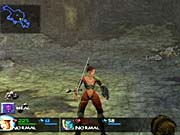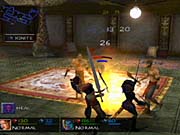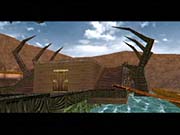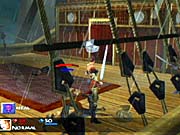Summoner: A Goddess Reborn
THQ and Volition bring the Summoner franchise to the GameCube.
THQ's Summoner series began a little more than two years ago on the PlayStation 2. The role-playing games were developed by Illinois-based Volition and revolved around individuals gifted with mystical powers. The franchise has spanned two games, Summoner and Summoner 2 on the PlayStation 2, and it has undergone quite a bit of refinement since the first game was available at the launch of the PlayStation 2. Following Summoner 2's release for the PlayStation 2 late last year, THQ announced that it planned to bring the franchise to the GameCube in 2003 with a conversion of Summoner 2 called Summoner: A Goddess Reborn. We got our hands on a previewable copy of the game and have come away pleased by the overhaul that's well under way.

Summoner: A Goddess Reborn's story is set roughly 20 years after the events depicted in the first game. You'll assume the role of Maia, the young ruler of a kingdom called Halassar who, according to nine out of 10 prophets, is believed to be the reincarnation of a goddess called Laharah. As if the pressures of being a reincarnated goddess and ruling a kingdom weren't enough, the prophecies also mention that Maia will fulfill a great destiny of some kind. Sadly, the exact nature of this destiny isn't covered in the prophecies, leaving Maia to her own devices. Fortunately, Maia's innate spunk sends her off to look for more information on her impending greatness. Maia's quest of self-discovery is complicated a bit by a declaration of war against Halassar from the priests of Urath. Krobelus, the leader of the priests, is pretty much set on completely wiping out Maia and her people, which rules out any kind of peaceful negotiation. While this all spells trouble for Maia, it's narrative gold for players looking for a meaty story.

In terms of gameplay, Summoner: A Goddess Reborn features a basic action adventure structure that's somewhat linear--you'll head out to different locales as the story unfolds--but it also offers some opportunities to go about your own business and revisit areas if you want. You'll go through the game with a party of three characters: Maia and two others. At the start of the game, your sole companion will be Sangaril, a Munari assassin who was originally assigned to kill Maia but ended up becoming her friend and confidant. As you progress, you'll meet and be able to swap in Taurgis, who is Maia's mentor and bodyguard; Neru, a former Urath priest who now leads a band of pirates; Iari, a machine created by an ancient race called the unseen; and Morbazan, a fighter who brings Maia information on Krobelus. You'll also cross paths with Yago, whose daughter, Rosalind--one of the main characters in the original Summoner--has gone missing. Each character will have unique abilities that can be very useful in specific situations, so choosing the right mix of characters is key to making it through the game.
The combat in Summoner: A Goddess Reborn is a solid mix of action RPG and turn-based RPG elements. You'll be able to swap between Maia and her party members during a battle. When you're actively controlling one of the characters, the game handles like a standard 3D action game. You'll lock on to enemies with the right trigger, attack with the B button, and block with the left trigger. You'll you'll also be able to pull off multiple-hit combos if you time your blows correctly. An onscreen meter will show the number of action points you currently have. The action points function a bit like mana or magic points do in a standard RPG--they're required to use certain items or perform special attacks. Maia differs a bit from the rest of the group because of her ability to transform into a variety of different creatures for certain periods of time. As you go through the game, you'll encounter runes that give Maia the ability to turn into the creatures. It's a nice addition that gives the gameplay some variety. The time limit on these transformations, which you can increase as Maia gains experience, adds a strategic element to the combat that keeps you from relying too heavily on them.

Exploration in the game is pretty standard. Every time you travel to a new location, you'll interact with characters who will usually offer some information and hints as to what you'll have to do. As in any RPG, you'll encounter a variety of puzzles to wrap your brain around, ranging from basic "find the key" challenges to more intricate, multiple-step tasks.
Graphically, the game looks sharp and improves on certain aspects of the PlayStation 2 version. The character design is true to the art style of the series, but the individual characters boast improved detail. Most of them also have clothing or hair that moves and animates well. In addition, the character design seems to draw on a wider pool of influences, and the end result is a richer overall look. The same can be said of the game's environments, which are expansive and sport a great deal of variety. For example, Maia's castle in Halassar has a Middle Eastern look that is conveyed by ornate tapestries and architecture. The enemies you'll face are equally varied and share the same level of detail and design as the main characters. You'll find quite a bit of eye candy, thanks to a host of new lighting and particle effects that are most often seen during the execution of spells magic and during Maya's transformations. The game's color, texture resolution, and lighting have also been freshened to take advantage of the GameCube hardware's strengths. Maia and Taurgis' character models have been redone as well. The most eye-catching improvement, however, is in the game's frame rate. Our preview build cruised along at 60 frames per second much of the time, although the frame rate bogged down a bit during combat.

Judging from what we've played so far, Summoner: A Goddess Reborn is coming together pretty well. The improved graphics, overhauled gameplay, and intriguing story are nice to see. While we would have liked to have seen some new content and more overhauled character models, this version still offers some solid improvements. GameCube owners looking for some RPG action should keep an eye out for it when it ships later this month.
Got a news tip or want to contact us directly? Email news@gamespot.com
Join the conversation